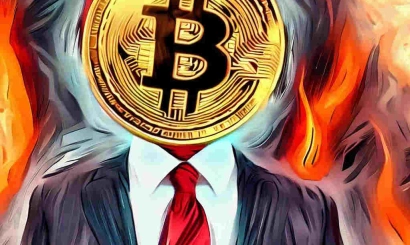Conditions for a Rally are Good. What Will Happen to Bitcoin in the Coming Week
Analysts told "soft4bro.com" what will happen to the Bitcoin exchange rate from June 10 to 16.
Experts analyzed the market situation and described how it might change in the upcoming week.
On Sunday, June 9, Bitcoin (BTC) is trading around $69.3k, with its price rising by about 2.5% over the past week. Specialists have analyzed the market situation and assessed the prospects for Bitcoin's movement in the next seven days.
"The situation remains favorable"
Financial Analyst at BitRiver Vladislav Antonov
Since the beginning of the week, Bitcoin has been trading up by 2.5%, despite a 2% loss on Friday. The market was volatile after the labor market report on Friday, but buyers prevented the price from falling significantly.
On June 3, the BTC/USDT pair rose by 1.54% to $68,809. During the European session, the price increased to $70,288, followed by a sharp pullback to $68,500. Against the backdrop of weak economic data and signs of slowing inflation, expectations of the Fed easing monetary policy supported Bitcoin.
On June 4, trading ended with Bitcoin rising by 2.51% to $70,537. The growth in quotes was driven by fundamental and technical factors, including expectations of a Fed rate cut.
On June 5, the BTC/USDT pair rose by 0.81% to $71,108, with the day's high at $71,758. Sales by the mining company Marathon Digital of some of their mined Bitcoins put some pressure on the market.
On June 6, Bitcoin rose by 0.43%, closing at $70,799. Trading was within the range of $70,117 - $71,700 amid stability in the US stock market.
On June 7, the BTC/USDt pair closed with a decline. Bitcoin fell by 2.04% to $69,365. The key event of the week was the publication of US employment data, which had a significant impact on market dynamics on Friday.
In the non-farm sector, 272,000 new jobs were created, which was higher than the average figure for the previous 12 months of 232,000 jobs.
The unemployment rate remained almost unchanged at 4.0%, and the total number of unemployed remained at 6.6 million. The average hourly wage in the private sector increased by 0.4% to $34.91, showing a 4.1% increase year-over-year. The labor force participation rate was 62.5%, and the employment rate was 60.1%, virtually unchanged from the previous month.
Carefully examining the report data, several points may be of interest to investors. There is a disparity in employment growth across different sectors. Although the labor market overall shows growth, there is a clear bias towards the service sector—healthcare, professional services, leisure, and hospitality. At the same time, the manufacturing sector (mining, construction, manufacturing) is showing stagnation in job creation. This could signal a potential slowdown in growth in these sectors in the future.
Overall, the data signals the continued strength of the labor market, but with potential risks of uneven growth between sectors, a shortage of skilled labor, and moderate wage dynamics, which could affect future economic indicators.
The publication of the employment report caused a sharp reaction in the markets. The dollar strengthened significantly, while risk assets showed a decline. Investors expect that with rising employment and wages, the Federal Reserve (Fed) may refrain from lowering interest rates until the end of 2024 in its fight against inflation.
The BTC/USDT pair fell to $68,420 but closed at $69,365. Analyzing five reports since the beginning of the year, it can be said that the market reacted weakly to the growth of jobs in the US, as all attention was focused on Bitcoin exchange-traded funds (ETFs). When strong figures were released, Bitcoin remained in a sideways trend, and when weak figures were released, it shot up. Since there was no news about Bitcoin, crypto investors reacted to US statistics and the dynamics of the dollar index.
According to Coinglass, on June 7, long positions on various tokens worth $361 million were liquidated, with $56.4 million in BTC.
NFP affects the market on Friday and partly on Monday. Then it is forgotten for a month. Although Bitcoin was shaken down by investor position liquidations, the situation remains favorable for its continued growth. Despite the price drop, it would not be surprising if it returns to $71,000 by the market opening on Monday.
According to BitRiver, Bitcoin is expected to continue growing next week and break through the resistance of $72,800 - $73,800. Conditions for a rally are good. It needs to break through to $75,000 for it to go "like clockwork."
"Almost succeeded"
Co-founder of ENCRY Foundation Roman Nekrasov
In the week ending June 9, Bitcoin attempted to consolidate above $70,000, and it almost succeeded. From June 4 to 7, Bitcoin traded above this mark and tested the next barrier at $71,000. But on Friday, the market turned sharply, and Bitcoin returned to the range below $70,000.
On June 4, Bitcoin sharply rose from $69,080 to $70,800. Mid-week, Bitcoin's growth was supported by a wave of optimism regarding an imminent reduction in the US key rate. For investors, the US regulator's monetary policy remains the main factor influencing the state of the crypto market.
Market participants were encouraged by the previously published data on declining inflation and hoped that the unemployment report, expected on Friday, June 7, would show a decrease in business activity and economic growth rates in the US, prompting the Fed to lower the key rate twice to stimulate the economy. The rise in the exchange rate was also helped by statistics on capital inflows into spot Bitcoin ETFs. On June 3, the second-largest net inflow of funds into these funds, amounting to $887 million, was recorded.
But the report on the US labor market situation, published on June 7, confused many. On the one hand, the number of unemployment benefit claims in the US rose more than expected—to 229,000 instead of the expected 220,000. On the other hand, the number of jobs in the non-farm sector (NFP) in the US increased by 272,000 in May, against the expected 185,000, indicating that the US economy is doing well even with a high key rate. This, in turn, reduced the likelihood of rate cuts.
Before the report was published, participants estimated the probability of a rate cut at the Fed's September meeting at 67%, but after the data was revealed, hopes fell to 55%, according to FedWatch CME Group surveys. The likelihood of two key rate cuts in 2024 also decreased—from 66% to 51%.
The crypto market immediately reacted with a sharp correction to the unemployment and employment data. Bitcoin lost almost $3,000 in two hours and nearly touched the $68,000 level, but bounced back and has been trading just above $69,000 since Friday.
Next week, increased volatility in Bitcoin and the entire crypto market can be expected around key events, which will also concern the main factor of possible growth or decline in the crypto market—the US monetary policy.
On June 12, the Federal Open Market Committee meeting will be held, where the rate will be discussed.
Although none of the market participants expect a decision to lower the key rate at the June meeting, everyone hopes to hear signals that this process will begin in the foreseeable future.
On June 12, the consumer price index will also be published, which is considered one of the main indicators taken into account by the regulator when discussing the key rate. In May, the index decreased by 0.1 percentage points to 3.4%. But even such a slight decrease had a positive impact on the trading participants' mood.
If consumer prices show a decline again, it may signal to the market that the key rate will still start to decline in the fall, which means an increase in appetite for risk assets. In this case, Bitcoin can regain positions lost after the publication of the unemployment report and surpass the $71,000 mark again.
It is not excluded that in this optimistic scenario, amid a wave of optimism, the inflow into spot Bitcoin ETFs will intensify, and by the end of next week, Bitcoin will approach $75,000.






